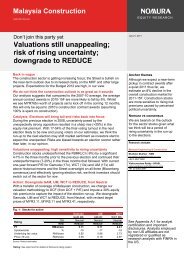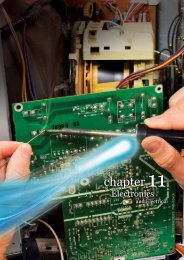Download PDF - ETP - Pemandu
Download PDF - ETP - Pemandu
Download PDF - ETP - Pemandu
Create successful ePaper yourself
Turn your PDF publications into a flip-book with our unique Google optimized e-Paper software.
<strong>ETP</strong> ANNUAL REPORT 2011<br />
Growing Wafer and Cell Producers<br />
Malaysia needs to increase its production capacity by 10fold<br />
to reach its goal of becoming the world’s second largest<br />
producer of solar cells. The target set for 2020 is a solar capacity<br />
of 23 gigawatts (GW) from the current 2.3GW. The fabrication<br />
of silicon wafers and photosensitive cells are the intermediate<br />
processes along the production chain from silicon feedstock<br />
to solar modules. The nation already has in place an attractive<br />
environment to attract multinational solar companies to our<br />
shores. This includes an established semiconductor industry with<br />
a value chain similar to that of solar cells. The Northern Corridor<br />
housing the semiconductor clusters is ideal for solar wafer and<br />
cell manufacturers with a ready supply of silicon coming from<br />
Sarawak.<br />
Achievements<br />
The achievements for total cell production capacity for 2011 was<br />
2.03GW installed capacity, which is 193% of the 2011 target of<br />
1.05GW. Additionally, AUO Sunpower announced the construction<br />
of a new facility in Melaka capable of generating more than 1,400<br />
megawatts of high-efficiency solar cells annually by 2013. The joint<br />
venture between Malaysia’s Sunpower and Taiwan’s AU Optronics<br />
designs, manufactures and delivers the most powerful solar cells<br />
in the world for use in virtually every sector of the economy.<br />
Increasing Solar Module Producers<br />
The availability of the Senai Airport and Tanjung Pelepas Seaport<br />
as well as proximity to Singapore’s Changi International Airport<br />
makes Johor an ideal location for module manufacturers targeting<br />
the markets of Southeast Asia, China, India and Australia. Malaysia’s<br />
attractive ecosystem can ensure the capture of a significant share<br />
of the modules market bearing in mind that demand is set to<br />
skyrocket in 2020 when all major Asian economies reach grid<br />
parity. This EPP has a target of bringing in two multinational<br />
module manufacturers and facilitating another five joint ventures.<br />
Achievements<br />
The achievements for 2011 were highly encouraging with two<br />
local companies successfully engaged in a Vendor Development<br />
Programme and one company out of the targeted two<br />
commencing production of solar modules.<br />
Moving Forward<br />
MIDA is working with the Iskandar Regional Development<br />
Authority (IRDA) to promote Johor as a hub for module<br />
production by offering pioneer status incentives to potential<br />
investors. One of the measures taken is to attract glass<br />
producers to Johor to complete the supply chain for solar<br />
module production. Glass is required to produce thin film solar<br />
modules. In the meantime, MOSTI is approaching universities<br />
128<br />
EPP 6<br />
EPP 7<br />
Moving Forward<br />
To achieve the 10-fold increase in solar cell production, MIDA<br />
has set a target of bringing in at least one company every year<br />
for the next 10 years, with the capacity to produce a cumulative<br />
2GW of wafers and cells. The lead agency for this EPP is offering<br />
pioneer-status incentives to prospective wafer and cell<br />
producers. Supporting MIDA’s efforts on this score is MOSTI,<br />
which is establishing a shared solar test centre that can provide<br />
product certification so as to lower start-up costs for individual<br />
manufacturers.<br />
Additionally, MOSTI will also establish a solar R&D lab and IP<br />
centre to research thin film and crystalline solar technology.<br />
Meanwhile, the Standards and Industrial Research Institute of<br />
Malaysia (SIRIM) is working to establish national standards for<br />
solar products to ensure safety and enhance the competitiveness<br />
of Malaysian products in the international markets. On their part,<br />
the PSDC and Selangor Human Resource Develop Centre (SHRDC)<br />
are collaborating with the private sector to introduce courses or<br />
modules in solar wafer and cell manufacturing to fulfil the human<br />
capital requirements.<br />
to provide technical advice and support in solar module R&D,<br />
technology platform and innovation for local small and medium<br />
enterprises (SMEs).<br />
Additionally, the Government is pursuing possible collaboration<br />
with neighbouring Singapore to attract solar investments<br />
spanning both Malaysia’s southernmost state and the island<br />
nation.<br />
Glass is required to produce thin film solar modules








